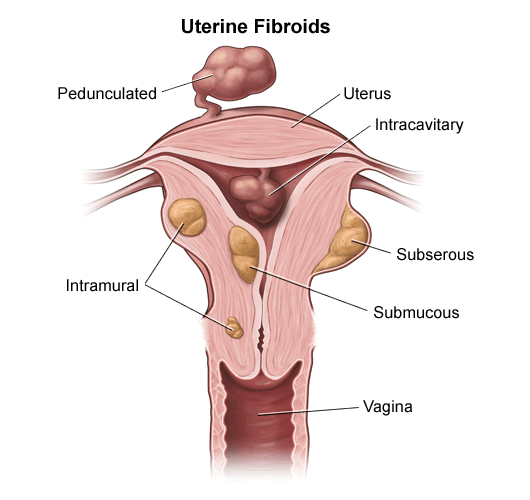Uterine fibroids, also known as leiomyomas or myomas, are non-cancerous growths that develop on a woman’s uterus. Rising from the smooth muscular tissue of the uterus (myometrium), a single cell divides repeatedly, eventually forming a benign tumor. Ranging in size, some fibroids go through growth spurts while others may shrink on their own. Their growth is often linked to estrogen levels due to the fact that they develop after puberty, typically around 30, and shrink and/or disappear post menopause. It has been found that as many as 3 out of 4 women (Mayo Clinic) have had uterine fibroids sometime during their lives, often unaware due to their asymptomatic nature.
Classified according to their location, size and number, there are several kinds of fibroids:

- Submucosal fibroids. Growing into the inner cavity of the uterus, submucosal fibroids can cause heavy menstrual flow and could potentially be a problem for women attempting pregnancy.
- Intramural fibroids. Found in the muscular uterine wall, if large enough, intramural fibroids may misshape the uterus, leading to heavy menses.
- Suberosal fibroids. Projecting to the outside of the uterus, subserosal fibroids can sometimes push on the bladder, leading to urinary symptoms.
- Pedunculated fibroids. Attached to the uterus by a base, inside or outside of the uterus, these fibroids can be painful if the blood supply to them is ceased.
According to the National Institute of Environmental Health Sciences, African-American women are twice more likely to develop fibroids than their Caucasian counterparts and about 80% of them will develop uterine fibroids by the age of 40.
Common symptoms of uterine fibroids include:
-Prolonged menstrual periods.
-Heavy menstrual bleeding.
-Frequent/urgent urination.
-Pelvic cramping and pain.
-Pain/pressure during sexual intercourse.
Although, larger uterine fibroids can be palpated during a pelvic examination, transabdominal or transvaginal ultrasound is typically used to detect fibroids. In cases where the ultrasound doesn’t provide enough information, and MRI could be utilized to create highly detailed images of the tumor. Hysterosalpingogram, is an X-ray image of the uterine cavity after a dye has been injected to highlight the pertinent structures.





